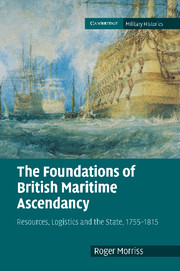Book contents
- Frontmatter
- Contents
- List of tables
- Preface
- Glossary of British weights, measures, casks and money values
- List of abbreviations
- Introduction
- 1 The British state in evolution
- 2 Defence and expansion
- 3 Economy and finance
- 4 Naval growth and infrastructure
- 5 Ordnance and technology
- 6 Manpower and motivation
- 7 Foodstuffs and victualling
- 8 Shipping and transportation
- 9 The supply of land forces overseas
- Conclusion
- Bibliography
- Index
Conclusion
Published online by Cambridge University Press: 10 January 2011
- Frontmatter
- Contents
- List of tables
- Preface
- Glossary of British weights, measures, casks and money values
- List of abbreviations
- Introduction
- 1 The British state in evolution
- 2 Defence and expansion
- 3 Economy and finance
- 4 Naval growth and infrastructure
- 5 Ordnance and technology
- 6 Manpower and motivation
- 7 Foodstuffs and victualling
- 8 Shipping and transportation
- 9 The supply of land forces overseas
- Conclusion
- Bibliography
- Index
Summary
This book has shown how the British state during the second half of the eighteenth century developed the logistical capability to project its military forces throughout the world. It has focussed on the branches of the state that met particular organisational and supply needs. Each of these branches of supply was important in its own right. But the development of each was shaped by three factors: by the insular nature of Britain which gave the sea an important influence on branches of supply; by the partnership of the state and the private sector; and by the ideas and ethics that both united the state and gave its bureaucracy a special administrative culture.
It is the contention of this book that the bureaucracy that served the armed forces developed its competence between 1755 and 1815, to reach its highest level of capability at the time Britain achieved dominance at sea during the first decade of the nineteenth century. It was a capability that served not only the navy but also the army, and brought with it the ability to command territory overseas, and mount campaigns distant from Britain. It was a capability that was enhanced by the growth of a maritime economy in which state spending strengthened domestic demand during wartime and stimulated those very resources – shipping, trade revenues, imports of food and naval stores – upon which the state depended to maintain its armed forces.
- Type
- Chapter
- Information
- The Foundations of British Maritime AscendancyResources, Logistics and the State, 1755–1815, pp. 396 - 403Publisher: Cambridge University PressPrint publication year: 2010

